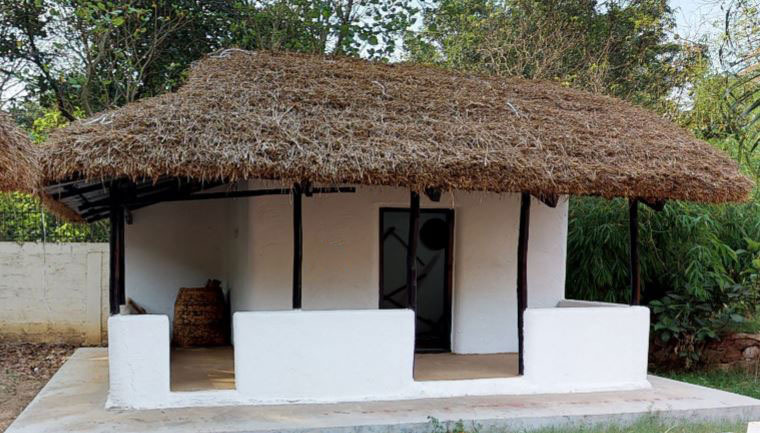Bhunjia on:
[Wikipedia]
[Google]
[Amazon]
Bhunjias, are an ethnic group found in India mainly reside in 
Sunabeda
Sunabeda is an industrial town and a municipality in the state of Odisha, India, located in the valleys of the Koraput region. The Engine division and Sukhoi division of the aircraft manufacturing company Hindustan Aeronautics Limited (HAL), a ...
plateau in Odisha and Chhattisgarh. They are mostly found in Nuapada
Nuapada is a town in western region of Odisha state of eastern India. It is the headquarter of Nuapada district. Nuapada district was carved out of the undivided Kalahandi district on 27 March 1993. It is on the western border of Odisha with Chh ...
district, which is roughly between 22° 55′ N and 21° 30′ N latitude and 82° 35′ E longitude. It was a part of Khariar Zamindari, which formed the eastern and the southeastern region of Raipur district
Raipur district is a district in the Chhattisgarh state of India. Its administrative headquarters is the city of Raipur. The district is rich in mineral resources and there are many wildlife sanctuaries. With a population of 2 million, it is the m ...
of Chhattisgarh division in Central Province till 1 April 1936, when it was transferred to Odisha
Odisha (English: , ), formerly Orissa ( the official name until 2011), is an Indian state located in Eastern India. It is the 8th largest state by area, and the 11th largest by population. The state has the third largest population of ...
on its creation. It is now in Komna block of Nuapada district in Orissa. In Chhattisgarh they are found in Raipur district.

History and origin myths
According to the tribe, the term "Bhunjia" means "growing out of land" or "origin from the earth". The Bhunjia have racial and cultural affinity with the Gonds of Orissa. There are many myths among the Bhunjia and the Gond, which speak of strong relationship among the Gonds and the Bhunjias. On setting in the Sunabeda plateau, the Bhunjias did not have marital relations with any tribal group, but in course of time, when the Gonds came into their area, marital relation was established with them. From this the population was divided into two inter-marrying groups, namely Markam and Netarn. Due to this close proximity with the Gonds, Bhunjias have adopted many of the Gods and Goddesses of the Gonds as their own. The two groups worship God and Goddesses common to the locality such as Budharaja and Sunadei.Culture
Bhunjias are divided into two main sections i.e. Chinda Bhunjia and Chaukhutia Bhunjia. The Chaukhutia Bhunjia are confined exclusively to the hills of the Sunabeda plateau in ecologically secluded areas for which they maintain distance from the outsiders. But the Chinda Bhunjia generally lives in the plains and have close contact with the tribal and non-tribal communities. The religious life of Bhunjia is very simple. They believe in many Gods and Goddesses who are worshipped in different months on different ritual occasions. Their major festivals are Dussehra, Chaval Dhona, Naya Khana. They practice monogamous marriage. Most prevalent methods of marriage are by exchange and elopement among others. They also practice levirate and sororate types of marriage. Bride price practice is not prevalent among them.Bhunjia Oral Tradition
The rich folklore of Bhunjia community has been documented by Dr Mahendra Kumar Mishra in his seminal book Oral Epics of Kalahandi 2007. The songs and tales, the myth of Goddess Sunadi, origin of paddy from Sunabeda, Bhujia myth of Origin are narrated in his book. Besides Surendra Kumar Mishra from Sinapali has written a book on Bhunjia Sanskruti O Lok Sahitya which has been published by the Academy of tribal language and culture, Bhubaneswar. The most important is their epic songs of Allah Udal, Tulsi beer, Mandhar MAjhi and life of Goddess Sunadi are some of the important narratives the Bhunjia singers, priests and Gurumai sing.Language
Bhunjia speakers belong to the Indo-Aryan language family as they speakBhunjia
Bhunjias, are an ethnic group found in India mainly reside in Sunabeda plateau in Odisha and Chhattisgarh. They are mostly found in Nuapada district, which is roughly between 22° 55′ N and 21° 30′ N latitude and 82° 35′ E longitude. It ...
, part of the Halbic languages
The Halbic languages belong to the eastern branch of the Indo-Aryan languages and are mainly spoken in southern Chhattisgarh in India. They are transitional between Odia and Marathi. They include Halbi, Kamar, Bhunjia
Bhunjias, are an ethn ...
, which is considered a mixture of Odia
Odia, also spelled Oriya or Odiya, may refer to:
* Odia people in Odisha, India
* Odia language, an Indian language, belonging to the Indo-Aryan branch of the Indo-European language family
* Odia alphabet, a writing system used for the Odia languag ...
, Marathi
Marathi may refer to:
*Marathi people, an Indo-Aryan ethnolinguistic group of Maharashtra, India
*Marathi language, the Indo-Aryan language spoken by the Marathi people
*Palaiosouda, also known as Marathi, a small island in Greece
See also
*
* ...
and Chhattisgarhi. However, S.C. Dubey, analyzing the myth and oral tradition
Oral tradition, or oral lore, is a form of human communication wherein knowledge, art, ideas and cultural material is received, preserved, and transmitted orally from one generation to another. Vansina, Jan: ''Oral Tradition as History'' (1985 ...
of Chhattisgarh, considers the Bhunjia as a branch of Halbas of Baster, who fled from Baster due to their quarrel with Dhakars.
References
{{Western Orissa Odia culture Social groups of Odisha